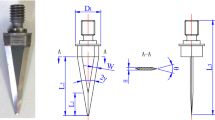Abstract
Revealing the ultrasonic cutting mechanism of honeycomb composite is important for determining the acoustic parameters of the ultrasonic system and selecting the parameters of the cutting process. Understanding more details of the stress on the cell wall from ultrasonic vibrating tool and the conditions for cell wall breakage is essential to study the machining mechanism. According to the evolution of contact state between the straight edge cutter and the honeycomb cell wall in a cycle, the cutting force acting on the cell wall is divided into three stages: transverse cutting load action, longitudinal cutting load action, and no cutting load action. The cell wall deflection and stress equations under transverse cutting load were established by applying elastic thin plate small deflection theory. The deformation and fracture characteristics of the honeycomb cell wall were analyzed by combining the analytical and the finite element model. The results showed that the ultrasonic vibration of the cutter greatly improved the stiffening effect of the cell wall and its fracture was caused by the deflection under the transverse cutting load, which exceeded the maximum allowable deformation after local stiffening. In addition, with only longitudinal cutting load, it was difficult to break the critical buckling state that leads to cell wall fracture.












Similar content being viewed by others
Data availability
This article contains all the data gathered or analyzed during this study.
References
Cheng W, Yuan C, Qiu Q, Wang Q, Chen J (2015) Honeycomb sandwich structure and manufacturing process in aviation industry. Aeronautical Manufacturing Technology 7:94–98
Gibson LJ, Ashby MF (1988) Cellular solids: structures & properties. Pergamon Press, Oxford
Hu XP, Yu BH, Li XY, Chen NC (2017) Research on cutting force model of triangular blade for ultrasonic assisted cutting honeycomb composites. In: Procedia CIRP. https://doi.org/10.1016/j.procir.2017.03.283
Wang Y, Wang X, Kang R, Sun J, Jia Z, Dong Z (2017) Analysis of influence on ultrasonic-assisted cutting force of nomex honeycomb core material with straight knife. J Mech Eng 53:73–82
Xiang D, Wu B, Yao Y, Zhao B, Tang J (2019) Ultrasonic vibration assisted cutting of nomex honeycomb core materials. Int J Precis Eng Manuf 20:27–36
Zhang Z (2011) Dimensionless unity and integration of engineer program I evaluation indicators. Power Syst Technol 35:352–354
Kang D, Zou P, Wu H, Duan J, Wang W (2019) Study on ultrasonic vibration–assisted cutting of Nomex honeycomb cores. Int J Adv Manuf Technol 104:979–992. https://doi.org/10.1007/s00170-019-03883-z
Xiu-xiu HU, Xiao-ping HU, Bao-hua YU (2015) Ultrasonic cutting force model of honeycomb composites and selection of the processing parameters. J Mech Electr Eng 2015(1):32–36, 95
Huang X, Hu X, Yu B, Wu S (2015) Research on ultrasonic cutting mechanism of Nomex honeycomb composites based on fracture mechanics. J Mech Eng 51:205–212. https://doi.org/10.3901/JME.2015.23.205
Li X, Hu X, Wu X, Yu B (2019) Research on ultrasonic machining simulation of finite element model for A ramid honeycomb material. J Hangzhou Dianzi University(Natural Sciences) 39(5):6–61
Roy R, Park S-J, Kweon J-H, Choi J-H (2014) Characterization of Nomex honeycomb core constituent material mechanical properties. Compos Struct 117:255–266
Timoshenko S-P (2009) Theory of elastic stability. Dover Publications Inc, New York
Lin J, Jin S, Zheng C, Yang F, Ding S (2017) Variation analysis of accumulative stresses in multistep assembly processes using output transformation matrices. Int Mech Eng Cong Expo 2:1–13
Xie S, Jing K, Zhou H, Liu X (2020) Mechanical properties of Nomex honeycomb sandwich panels under dynamic impact. Compos Struct 235:111814
Seemann R, Krause D (2017) Numerical modelling of Nomex honeycomb sandwich cores at meso-scale level. Compos Struct 159:702–718
Thoe TB, Aspinwall DK, Wise MLH (1998) Review on ultrasonic machining. Int J Mach Tools Manufact 38(4):239–255
Funding
The National Natural Science Foundation of China (No.51975173), Zhejiang Province Public Welfare Technology Application Research Project (No. LGG21E050010),
Author information
Authors and Affiliations
Contributions
Baohua Yu comprehensively analyzed the simulation and data results, drew conclusions and wrote part of the paper. Sufang Yao deduced the theoretical equation, did experiments, and wrote part of the paper. Xin Wu did simulation experiments. Xiaoping Hu designed and studied the technical route.
Corresponding author
Ethics declarations
Ethics approval and consent to participate
None of the studies mentioned in this article contain any human participation. Also, no animals were harmed during these experiments. The authors consent to participate.
Consent for publication
The authors provide their consent to publish this article.
Competing interests
The authors declare no competing interests.
Additional information
Publisher's Note
Springer Nature remains neutral with regard to jurisdictional claims in published maps and institutional affiliations.
Rights and permissions
About this article
Cite this article
Yu, B., Yao, S., Wu, X. et al. Cell wall fracture mechanism in ultrasonic-assisted cutting of honeycomb materials. Int J Adv Manuf Technol 121, 5067–5078 (2022). https://doi.org/10.1007/s00170-022-09671-6
Received:
Accepted:
Published:
Issue Date:
DOI: https://doi.org/10.1007/s00170-022-09671-6



